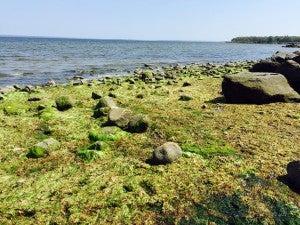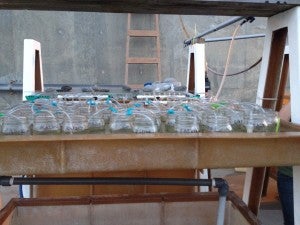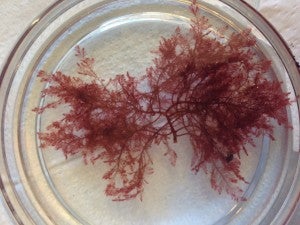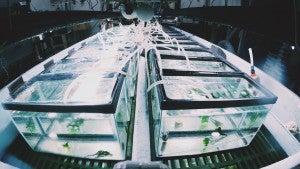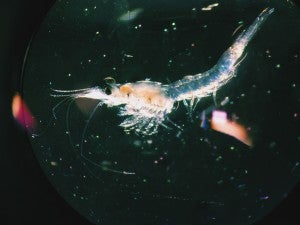MACROALGAL BLOOMS
Large accumulations of macroalgae are a cosmopolitan phenomenon of protected, eutrophied estuaries around the world. These prolific blooms (>700g wet mass/square meter) are a persistent feature of shallow areas of Narragansett Bay, RI during the summer months, although their abundance and species composition varies both spatially and temporally. Numerous invertebrate species are associated with these macroalgal blooms. We are investigating a myriad of ecological interactions between bloom species and herbivores, including herbivory, facilitation of bloom growth through herbivore overcompensation and competitive release, and decay. We are also interested in competitive interactions among bloom-forming macroalgal species.
The origin and movement of macroalgal blooms is not well understood in Narragansett Bay. We are currently collaborating with Dr. Stephen Licht (URI, Ocean Engineering) to develop technology to track macroalgal blooms using unmanned aerial vehicles (UAVs) in order to better understand bloom formation and movement. We are also interested in the impacts of climate change on macroalgal bloom dynamics, including gene expression and life cycle dynamics (a joint project with Dr. JD Swanson, Salve Regina University), and macroalgal physiology.
EPIPHYTE-HERBIVORE INTERACTIONS
TROPHIC DYNAMICS, INCLUDING INVASIVE SPECIES
Trophic dynamics play important and vital roles in structuring ecological communities. We investigate trophic linkages (plant-herbivore and herbivore-predator) in a variety of marine and terrestrial systems, to better understand the nature of (and strengths of) these interactions. When invasive species become established in an area and form new trophic linkages, there is potential for the entire community structure to become altered (through direct and/or indirect interactions). Invasive species can be found on every trophic level, including primary producers, herbivores, and predators. We thus are very interested in the trophic dynamics of these species as they become established members of their communities. Currently, we are investigating: 1) the impacts of the invasive hemlock wooly adelgid, Adelges tsugae, and invasive elongate hemlock scale, Fiorinia externa, on New England eastern hemlock forests (a joint project with Dr. Evan Preisser’s laboratory at URI and Dr. Colin Orian’s laboratory at Tufts University), and 2) the impacts of the newly invasive red seaweed species ‘Heterosiphonia’ japonica’ on subtidal rocky reefs throughout New England (a joint project with Dr. Matthew Bracken’s laboratory at Northeastern University/UC Irvine).
OCEAN ACIDIFICATION
While ocean acidification is expected to have a detrimental impact on the health and function of calcifying organisms, marine primary producers may benefit from the excess carbon dioxide in the water column. We are investigating how ocean acidification combines with other environmental factors to influence the growth and productivity of subtidal macroalgae and how these factors are influencing trophic dynamics and interspecific competition. This research is interpreted in the context of ecosystem response to climate change.
EVOLUTIONARY ADAPTATION TO CLIMATE CHANGE
Climate change is altering marine environments, forcing species to move or adapt. Here we are investigating the ability of marine organisms to adapt to the change. Working with a species of mysid shrimp found in Narragansett Bay, we are testing how baseline morphology, life history, and fitness changes after populations are kept under different temperature regimes for multiple generations. This work is a joint project with URI’s Dr. Jason Kolbe and the EPA’s Dr. Jason Grear.
 Home
Home Browse
Browse Close
Close Events
Events Maps
Maps Email
Email Brightspace
Brightspace eCampus
eCampus



